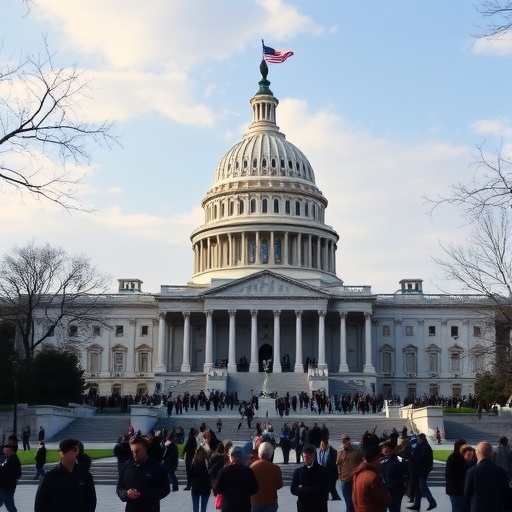Congress Braces for Government Shutdown as Federal Budget Negotiations Stall in Washington
In a high-stakes standoff that’s gripping the nation’s capital, Congress is racing against the clock to avert a government shutdown, with the federal budget deadline looming just days away. As lawmakers in Washington dig in their heels, partisan tensions are boiling over, threatening to halt federal operations and disrupt millions of American lives. The impasse, centered on deep divisions over spending priorities, has both Democrats and Republicans pointing fingers, escalating what could become the fourth partial shutdown in a decade.
- Partisan Finger-Pointing Escalates Over Budget Priorities
- Sticking Points in Federal Budget Talks: From Defense to Social Programs
- Economic Ripples from a Potential Washington Shutdown
- Lawmakers’ Voices Echo Amid Tense Capitol Hill Sessions
- Path Forward: Deadlines, Deals, and What Lies Ahead for Congress
The urgency couldn’t be higher: without a deal by midnight on Friday, non-essential government services could grind to a halt, furloughing hundreds of thousands of federal workers and stalling everything from national park access to veterans’ benefits. This crisis isn’t just political theater—it’s a real threat to the economy, with past shutdowns costing billions in lost productivity. As negotiations drag on in smoke-filled rooms on Capitol Hill, the American public watches anxiously, wondering if compromise is possible or if gridlock will prevail once again.
Partisan Finger-Pointing Escalates Over Budget Priorities
The blame game in Congress has reached fever pitch, with Democrats accusing Republicans of holding the federal budget hostage to appease their far-right base, while Republicans counter that Democrats are pushing for unchecked spending that balloons the national debt. House Speaker Mike Johnson, R-La., took to the floor yesterday, declaring, “We’re not going to rubber-stamp a bloated budget that ignores fiscal responsibility. The American people deserve better than this reckless spending spree.”
On the other side, Senate Majority Leader Chuck Schumer, D-N.Y., fired back during a press conference, stating, “Republicans are playing politics with people’s livelihoods. Their demands for deep cuts to essential programs like Medicaid and food assistance are a non-starter. We need real negotiations, not ultimatums.” This rhetoric underscores the core divide: Republicans are demanding at least $2 trillion in spending reductions over the next decade, focusing on discretionary programs and green energy initiatives from the Inflation Reduction Act, while Democrats insist on protecting social safety nets and investing in infrastructure.
Historical context adds weight to the drama. The last major government shutdown in 2018-2019 lasted 35 days, the longest in U.S. history, and cost an estimated $11 billion in economic damage, according to the Congressional Budget Office (CBO). That episode furloughed 800,000 federal employees and delayed paychecks for many more. With inflation still hovering around 3% and the national debt surpassing $34 trillion, lawmakers are under immense pressure to avoid repeating such chaos.
Behind the scenes, Washington insiders report that informal talks between key committee chairs have yielded little progress. The House Appropriations Committee, chaired by Rep. Tom Cole, R-Okla., proposed a stopgap funding bill last week that included $1.5 trillion for defense but slashed funding for the Environmental Protection Agency by 15%. Democrats rejected it outright, calling it “a poison pill designed to fail.”
Sticking Points in Federal Budget Talks: From Defense to Social Programs
At the heart of these federal budget negotiations are irreconcilable differences on funding allocations. Defense spending, a perennial flashpoint, is set to receive a proposed $886 billion boost in the upcoming fiscal year, up 4.1% from current levels, as outlined in President Biden’s initial budget request. Republicans, led by hawks like Sen. Lindsey Graham, R-S.C., argue this is insufficient amid global threats from China and Russia, pushing for an additional $50 billion to bolster military readiness.
Conversely, Democrats prioritize domestic programs. The proposed budget includes $1.7 trillion for non-defense discretionary spending, covering education, housing, and healthcare. A key battleground is the Supplemental Nutrition Assistance Program (SNAP), where Republicans seek to impose stricter work requirements, potentially affecting 1.5 million recipients, per USDA estimates. “These aren’t just numbers on a page,” said Rep. Rosa DeLauro, D-Conn., ranking member of the Appropriations Committee. “They’re about feeding hungry families and ensuring kids have a fair shot.”
Another contentious area is border security. With migrant encounters at the southern border exceeding 2.4 million in fiscal 2023, according to Customs and Border Protection data, Republicans are demanding $20 billion for wall construction and additional agents. Democrats counter with a more holistic approach, allocating funds for asylum processing and humanitarian aid, totaling $15 billion. This divide has stalled progress in bipartisan working groups, with one aide anonymously telling reporters, “We’re talking past each other—it’s like herding cats in a thunderstorm.”
Statistics paint a stark picture of the stakes. The CBO projects that without a budget deal, the government shutdown could shave 0.2% off GDP growth in the first quarter of next year, exacerbating supply chain issues still lingering from the pandemic. Federal contractors, who employ over 5 million workers, are already bracing for delays in payments, as seen in previous shutdowns where small businesses lost an average of $10,000 per day.
Economic Ripples from a Potential Washington Shutdown
The threat of a government shutdown isn’t confined to Capitol Hill—its shockwaves could reverberate through the entire U.S. economy. Financial markets are jittery, with the Dow Jones Industrial Average dipping 150 points yesterday on shutdown fears. Economists at Moody’s Analytics warn that even a short shutdown could cost $1.5 billion per week in lost output, hitting sectors like tourism and agriculture hardest.
Consider the human element: During the 2013 shutdown, which lasted 16 days, national parks closed, costing $76 million in visitor spending alone, according to the National Park Service. Veterans’ services were disrupted, with over 400,000 claims delayed, leading to widespread frustration among the 18 million U.S. veterans. This time, with active-duty military pay protected by law, the focus shifts to civilian employees—about 2.1 million could face furloughs, drawing on savings or seeking unemployment benefits that might not kick in immediately.
Washington‘s local economy, heavily reliant on federal jobs, stands to suffer most. The D.C. metro area employs over 300,000 federal workers, and a shutdown could spike unemployment claims by 20%, per regional forecasts. Restaurants, retailers, and ride-share services in the capital would feel the pinch, as furloughed workers cut back on spending. “We’ve been through this before,” said Sarah Jenkins, owner of a small eatery near the Capitol. “Last time, my revenue dropped 40%. Families can’t afford another hit.”
Broader implications include delayed IRS tax refunds—potentially $100 billion worth—and halted research grants at agencies like the NIH, stalling medical breakthroughs. The Small Business Administration’s loan programs, vital for entrepreneurs, would pause, echoing the 2020 pandemic disruptions. As one Wall Street analyst noted in a recent Bloomberg report, “Investor confidence is fragile; a shutdown could trigger a sell-off reminiscent of 2018.”
Lawmakers’ Voices Echo Amid Tense Capitol Hill Sessions
From the marble halls of the Capitol to virtual town halls, lawmakers are making their cases directly to constituents. Rep. Marjorie Taylor Greene, R-Ga., a vocal conservative, rallied supporters on social media, posting, “Time to drain the swamp! No more funding for woke agendas—shutdown if necessary to save America.” Her stance resonates with the House Freedom Caucus, which boasts 45 members and has vowed to vote against any bill without major concessions.
Moderate voices urge restraint. Sen. Susan Collins, R-Maine, co-chair of the Bipartisan Budget Group, emphasized in an interview with CNN, “We’ve seen the devastation shutdowns cause. I call on my colleagues to return to the table for good-faith negotiations. Our veterans, farmers, and first responders deserve stability.” On the Democratic side, progressive firebrand Rep. Alexandria Ocasio-Cortez, D-N.Y., tweeted, “Republicans want to gut programs that help working families while padding Pentagon pockets. This is class warfare, plain and simple.”
Bipartisan efforts aren’t entirely dead. A group of 20 centrist senators, including Sens. Kyrsten Sinema, I-Ariz., and Joe Manchin, D-W.Va., met privately last night to draft a compromise bill. Their proposal floated a $1.8 trillion omnibus package with phased-in cuts to non-defense spending and increased border funding, but sources say it faces uphill battles in both chambers. “We’re close, but trust is in short supply,” one participant confided to Politico.
Public opinion polls reflect the frustration. A recent Quinnipiac survey found 62% of Americans disapprove of Congress‘ handling of the federal budget, with independents particularly weary of the partisan brinkmanship. Veterans’ groups like the American Legion have flooded Hill offices with calls, urging passage of a clean continuing resolution to keep services running.
Path Forward: Deadlines, Deals, and What Lies Ahead for Congress
As the clock ticks toward the Friday deadline, Congress faces a series of procedural hurdles. The House is scheduled for a marathon session today, where Speaker Johnson could attempt to bring a short-term funding bill to the floor under suspension of the rules, bypassing the Freedom Caucus. If it passes, the Senate would need 60 votes to overcome a filibuster—a tall order given the razor-thin margins.
Looking ahead, experts predict a likely short-term extension if cooler heads prevail, buying time for comprehensive negotiations into the new year. However, failure could lead to a prolonged government shutdown, forcing President Biden to declare emergencies for essential services like air traffic control and Social Security payments. The White House has already prepared contingency plans, with Press Secretary Karine Jean-Pierre stating, “We’re monitoring closely and urging Congress to act responsibly.”
Long-term, this impasse highlights deeper dysfunction in Washington. With midterm elections on the horizon, both parties are posturing for political gain, but at what cost? Bipartisan commissions, like the Simpson-Bowles panel from 2010, have long recommended structural reforms to the budgeting process, such as automatic sequesters or biennial budgets, to prevent future crises. Yet, implementation remains elusive.
For everyday Americans, the message is clear: brace for uncertainty. Families relying on federal aid, businesses awaiting contracts, and travelers planning park visits could all be upended. As one Capitol Hill veteran put it, “This isn’t just about dollars—it’s about delivering on the promise of government for the people.” Whether Congress rises to the occasion or succumbs to gridlock will define the coming weeks, with ripple effects felt far beyond the Beltway.
In the end, the path to resolution lies in compromise, but with tempers flaring and deadlines pressing, the nation holds its breath for a breakthrough—or breakdown—in these critical federal budget negotiations.









